Why Tank Base Sealing Systems Fail and How to Protect Tank Bases
Industrial storage tanks and their contents are extremely valuable assets that need protection. The installation of these storage tanks is usually on a concrete pedestal with a bed of sand. Over time, the tank bases deteriorate by corrosion at the chime angle, annular ring or on the track underneath due to:
- Water ingress
- Poor drainage
- Sloping foundations
- Extreme weather conditions such as rain, heat, UV degradation
- Operating conditions such as heavy loading
- Tank movement
Conventional sealing methods for tank base sealing, such as mastic tapes, often fail due to shrinkage and UV attack. As part of industrial tank maintenance, asset owners can use breathable microporous membranes to restore and extend the lifespan of the tank foundation.
Belzona 3111 (Flexible Membrane) for Tank Base Protection
Belzona 3111 (Flexible Membrane) is a water-based microporous membrane system that can restore and extend the lifespan of tank bases. This permeable membrane can resist water penetration beneath the tank chimes or bases while allowing moisture to escape from within. It helps mitigate the risks of severe corrosion such as pitting corrosion, galvanic corrosion, or crevice corrosion on tank bottoms.
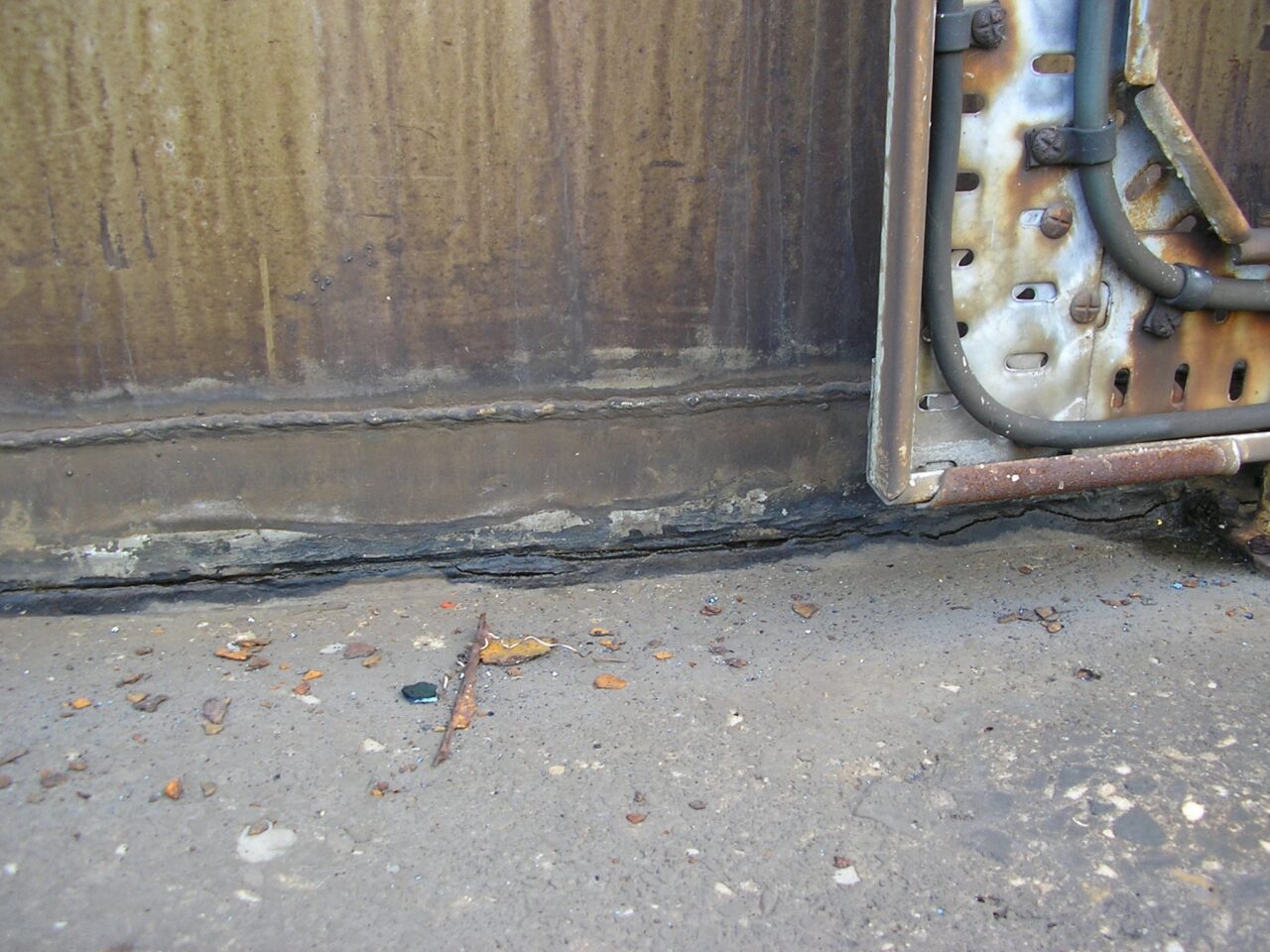
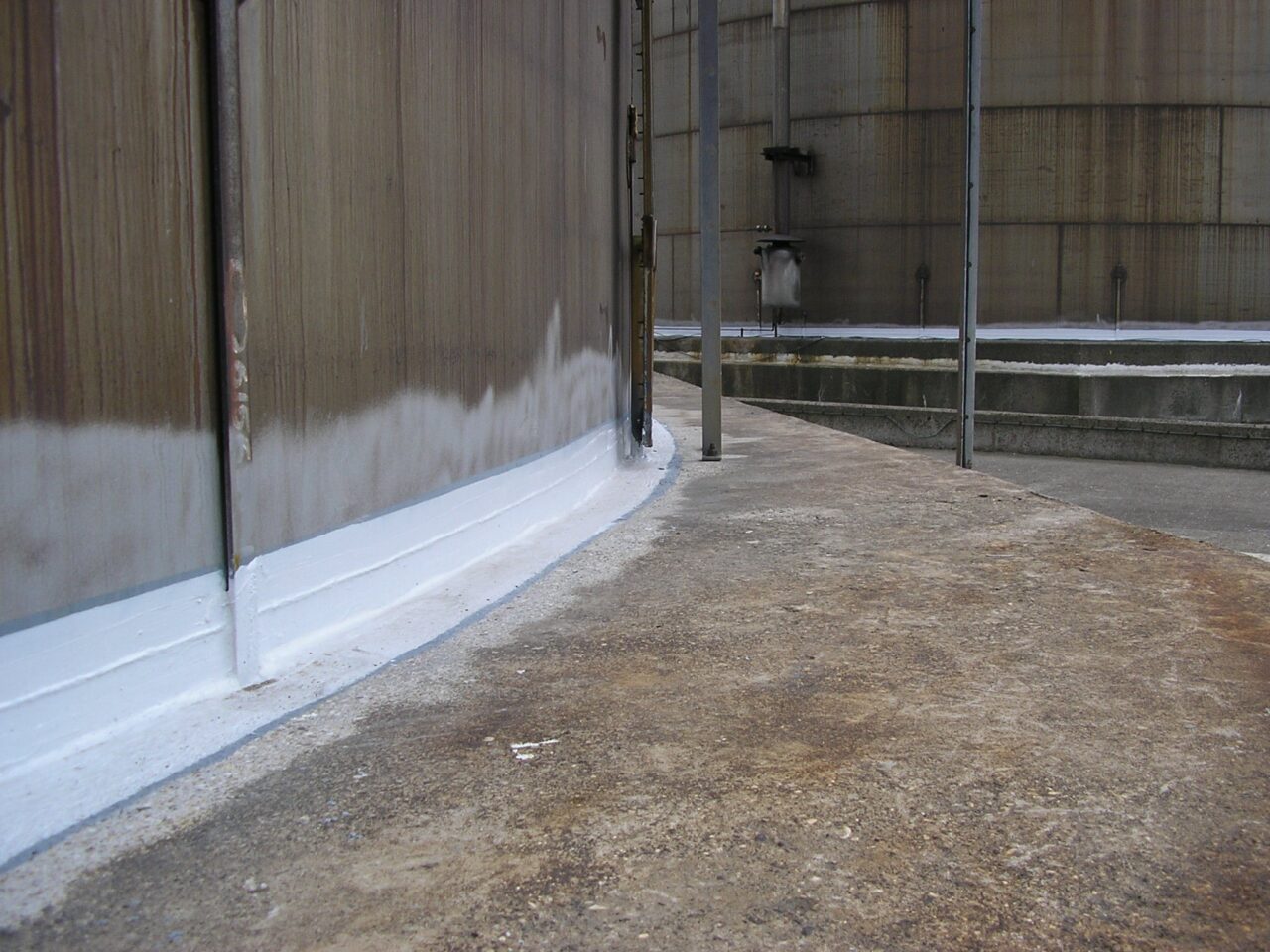
In addition to providing water ingress protection, the UV-resistant waterproofing membrane, Belzona 3111 (Flexible membrane), can protect tank bases from infrared and ultra violet exposure. By using this membrane, asset owners can carry out non-destructive testing (NDT) for maintenance inspections without causing harm or disruptions to operations.
Other Belzona breathable membranes can be used as alternatives, the table below provides guidelines on how to select suitable coating systems and the appropriate Belzona reinforcement sheet to protect tanks. For more information, please contact Belzona Distributors in your region.
| System Requirement | Belzona 3111 (Flexible Membrane) | Belzona 3211 (Lagseal) | Belzona 3121 (MR7) | Belzona 3131 (WG Membrane) |
| Maximum fire resistance | ⚫ | |||
| Maximum weather resistance | ⚫ | ⚫ | ||
| Weather tolerant application | ⚫ | ⚫ | ||
| Low odor | ⚫ | ⚫ | ||
| Emergency situations | ⚫ |
Step-by-Step Guide: How to Install Tank Base Protection with Belzona 3111 (Flexible Membrane)
Step 1: Surface Preparation Prior to Application of Belzona Tank Base Sealing
Remove any loose mastic, sealant, and worn-out materials on the tank base. The corroded annular ring should be grit blasted to achieve cleanliness standard Sa 2 ½ with 50 – 75 micron (2-3 mil) profile. For areas with only light corrosion, handheld tools are sufficient for surface preparation on the annular ring and tank wall.
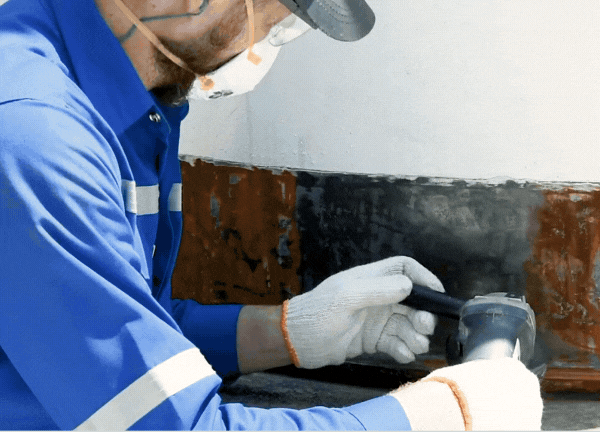
Step 2: Define the Repair Area
Mark the repair area by applying masking tape around the tank. Masking tape will help control the application of the conditioner prior to application of the coating for tank base sealing, and prevent the materials from extending beyond the repair area.
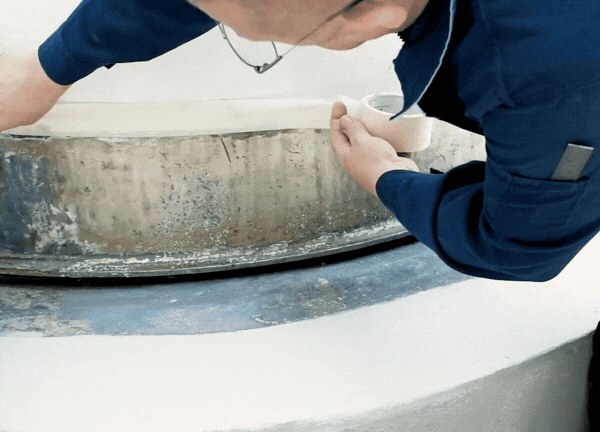
Step 3: Apply Conditioner Prior to Application of Breathable Coating for Tank Base
Apply Belzona 3921 (GSC Surface Conditioner) on the annular ring and tank foundation using a brush. Belzona recommends using Belzona 3921 (GSC Surface Conditioner) for both steel and concrete substrates. Next, remove the masking tape and allow the conditioner to dry for a minimum of four hours but no longer than two days. Note that if the repair uses Belzona 3121 (MR7), the conditioner is not necessary.
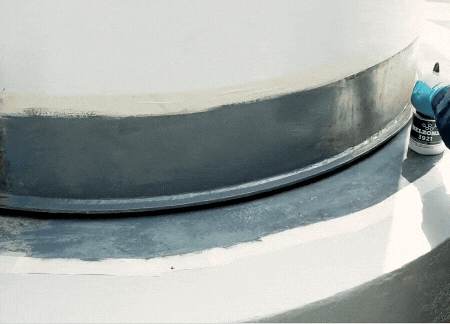
Step 4: Insert Backer Rod into the Void Between the Tank Chime and the Concrete Base
Over time, water ingress and tank movement may cause gaps and voids between the tank chime and base. If this happens, fill the voids between the annular ring and tank base with an extruded polyethylene backer rod. The backer rod will provide support for the bridging tape.
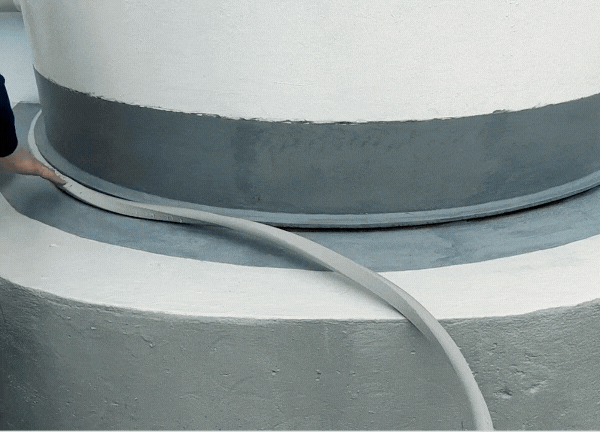
Step 5: Apply Bridging Tape over the Joint between the Tank and the Concrete Base
Apply bridging (duct) tape or plastic backed adhesive tape directly over the joint between the tank and the concrete base. Ensure the tape adheres well to both the steel and the concrete. This will support a uniform application of the tank base protection and help create a neat repair.
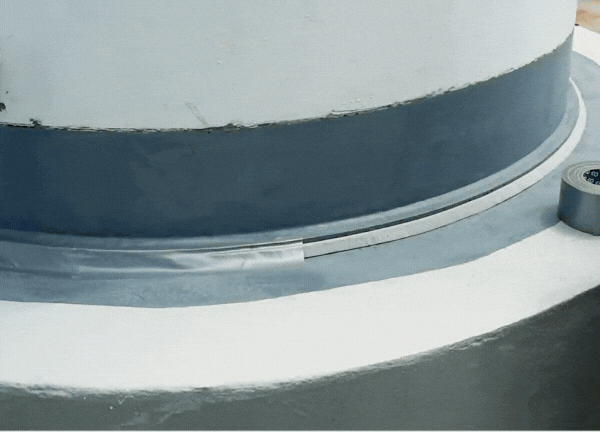
Step 6: Mark the Area for Application of Belzona 3111 (Flexible Membrane)
Apply masking tape to define the repair area required prior to the application of Belzona 3111 (Flexible Membrane) for tank base sealing. The tape helps control the application of the permeable membrane. Depending on the application and operating conditions, asset owners may consider other membranes such as Belzona 3121 (MR7), Belzona 3131 (WG Membrane), Belzona 3211 (Lagseal).
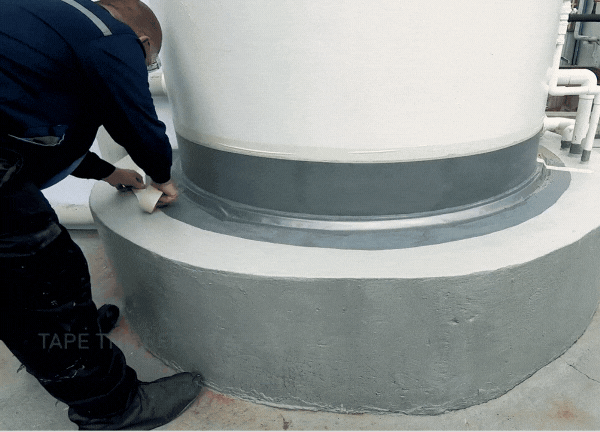
Step 7: Application of the Reinforcement Sheet
Position the pre-measured and pre-cut Belzona 9311 (Reinforcement Sheet) on the substrate of the tank wall and the annular ring. Then, apply the first coat of the UV resistant waterproofing membrane, Belzona 3111 (Flexible Membrane) over the Belzona 9311 (Reinforcement Sheet) and wet it out completely. Make sure the reinforcement sheet follows the surface contours as closely as possible without stretching or creasing.
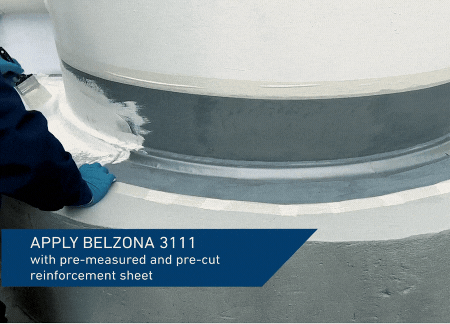
Step 8: Application of the Second Coat of Belzona 3111 (Flexible Membrane)
Once the first coat is dry, apply the second coat of Belzona 3111 (Flexible Membrane) to give a smooth finish and ensure full coverage, including pinholes. The two-coat system will provide water ingress protection and UV resistance for the tank base. For other coating grades for tank base protection, Belzona recommends asset owners follow the manufacturer’s instructions for use.
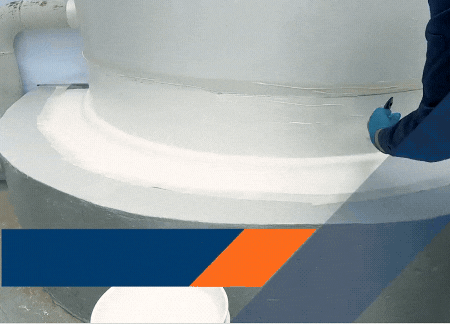
Step 9: Remove the Tape and Allow the Coating to Dry
Once the application of the second coat is complete, remove the tape. Then allow the coating to dry. Belzona 3111 (Flexible Membrane) will be water resistant within 30 minutes after application under good drying conditions – that is, when there is no rain, snow, fog, or frost; surface temperature is above 41°F (5°C) and rising; and relative humidity remains below 80%. Under cool and humid conditions, the drying time will be extended.
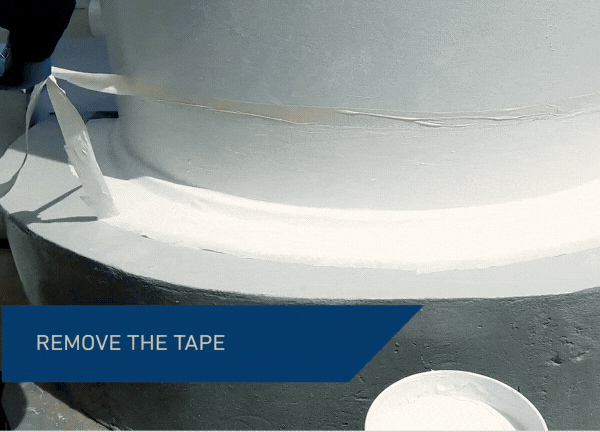
Video: How to Install Tank Base Sealing with Belzona 3111 (Flexible Membrane)
Frequently Asked Questions
How do microporous membranes prevent corrosion at tank bases?
Microporous membranes prevent corrosion at tank bases by forming a breathable yet waterproof barrier. These coatings block external elements like water, salts, and contaminants from infiltrating the tank base while allowing trapped moisture or vapor beneath the tank to escape through their microporous structure. This dual functionality prevents moisture accumulation – a primary cause of corrosion at tank bases.
How does Belzona 3111 (Flexible Membrane) offer better protection than traditional tank base sealing systems?
Belzona has developed Belzona 3111 (Flexible Membrane), a versatile liquid-applied coating, that can not only prevent water ingress but also resist UV exposure. While ensuring an effective barrier against water penetration, its UV-resistant properties ensure that the coating does not degrade over time. These properties allow Belzona 3111 (Flexible Membrane) to enhance the protection of the tank base sealing system for the long term.
What types of tanks can Belzona tank base sealing system repair?
Thanks to its versatility, Belzona’s tank base sealing system is capable of adhering to a wide range of surfaces including asphalt, concrete, and other porous or bituminous materials – as well as non-porous surfaces like glass, slate, lead, copper, and aluminum (excluding Plexiglas and most plastics). This adhesion capability allows asset owners to protect the bases of various types of industrial vertical storage tanks, such as stainless steel tanks, FRP tanks, GRP storage tanks, API 650 storage tanks, API 620 storage tanks, silos, and process tanks, regardless of the materials.
Can asset owners use Belzona coatings to protect other structure foundations such as distillation columns or wind turbine bases?
In industrial environments, structural foundations play a critical role in maintaining asset integrity. Belzona membrane coatings are not limited to tank bases. They can also protect the foundations of other structures, such as distillation columns, wind turbine bases, and electrical transmission tower foundations. These cold-applied systems offer long-term protection, weatherproofing, and water resistance, helping to prevent degradation caused by environmental exposure, water ingress or ground movement.
Learn More
Storage Tank Farm Provided with a Total Refurbishment
Belzona Corrosion Protection System Seals Oil Storage Tanks
Contact Belzona to Learn More about Tank Base Sealing

Natalija Skrlec joined Belzona in 2022; since then she has been promoted to the position of Technical Service Engineer based at the Company’s Headquarters in Harrogate. Her main responsibilities involve delivering technical application support and hands-on training in English and German speaking markets.
She graduated with a master’s degree from the University of Ljubljana in Slovenia in 2009 and holds an AMPP (NACE) Coating Inspector Level 1 certification.
Through her technical knowledge and hands-on experience, Natalija supports the application of Belzona’s polymeric solutions across multiple industries worldwide. She is passionate about continuous knowledge exchange, and believes it is the key to engineering excellence and Distributor success.


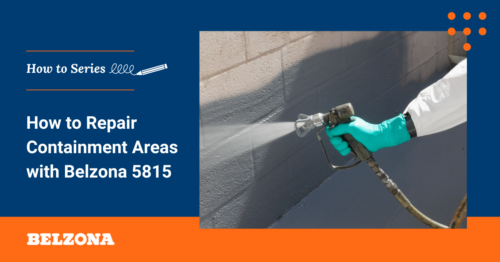
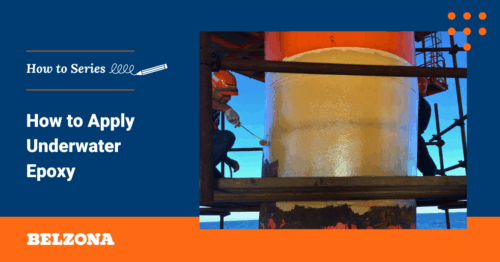
Gracias Natalija por tu descripción, paso a paso, de cómo instalar SEAL-A-TANK ¡¡
Excellent work Natalija!